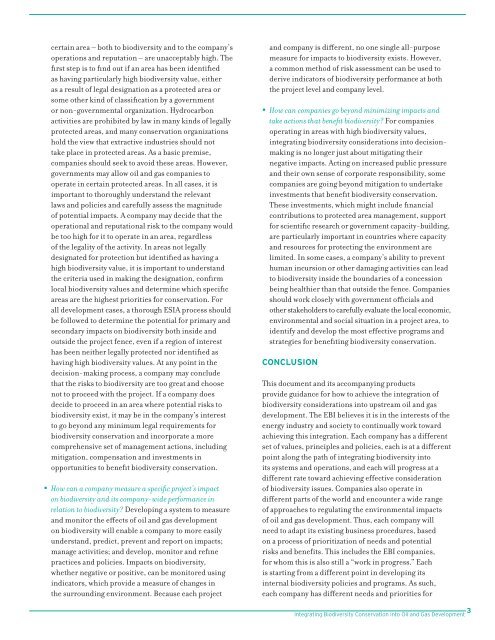Integrating Biodiversity Conservation into Oil and Gas ... - EBI
Integrating Biodiversity Conservation into Oil and Gas ... - EBI
Integrating Biodiversity Conservation into Oil and Gas ... - EBI
You also want an ePaper? Increase the reach of your titles
YUMPU automatically turns print PDFs into web optimized ePapers that Google loves.
certain area – both to biodiversity <strong>and</strong> to the company’s<br />
operations <strong>and</strong> reputation – are unacceptably high. The<br />
first step is to find out if an area has been identified<br />
as having particularly high biodiversity value, either<br />
as a result of legal designation as a protected area or<br />
some other kind of classification by a government<br />
or non-governmental organization. Hydrocarbon<br />
activities are prohibited by law in many kinds of legally<br />
protected areas, <strong>and</strong> many conservation organizations<br />
hold the view that extractive industries should not<br />
take place in protected areas. As a basic premise,<br />
companies should seek to avoid these areas. However,<br />
governments may allow oil <strong>and</strong> gas companies to<br />
operate in certain protected areas. In all cases, it is<br />
important to thoroughly underst<strong>and</strong> the relevant<br />
laws <strong>and</strong> policies <strong>and</strong> carefully assess the magnitude<br />
of potential impacts. A company may decide that the<br />
operational <strong>and</strong> reputational risk to the company would<br />
be too high for it to operate in an area, regardless<br />
of the legality of the activity. In areas not legally<br />
designated for protection but identified as having a<br />
high biodiversity value, it is important to underst<strong>and</strong><br />
the criteria used in making the designation, confirm<br />
local biodiversity values <strong>and</strong> determine which specific<br />
areas are the highest priorities for conservation. For<br />
all development cases, a thorough ESIA process should<br />
be followed to determine the potential for primary <strong>and</strong><br />
secondary impacts on biodiversity both inside <strong>and</strong><br />
outside the project fence, even if a region of interest<br />
has been neither legally protected nor identified as<br />
having high biodiversity values. At any point in the<br />
decision-making process, a company may conclude<br />
that the risks to biodiversity are too great <strong>and</strong> choose<br />
not to proceed with the project. If a company does<br />
decide to proceed in an area where potential risks to<br />
biodiversity exist, it may be in the company’s interest<br />
to go beyond any minimum legal requirements for<br />
biodiversity conservation <strong>and</strong> incorporate a more<br />
comprehensive set of management actions, including<br />
mitigation, compensation <strong>and</strong> investments in<br />
opportunities to benefit biodiversity conservation.<br />
• How can a company measure a specific project’s impact<br />
on biodiversity <strong>and</strong> its company-wide performance in<br />
relation to biodiversity? Developing a system to measure<br />
<strong>and</strong> monitor the effects of oil <strong>and</strong> gas development<br />
on biodiversity will enable a company to more easily<br />
underst<strong>and</strong>, predict, prevent <strong>and</strong> report on impacts;<br />
manage activities; <strong>and</strong> develop, monitor <strong>and</strong> refine<br />
practices <strong>and</strong> policies. Impacts on biodiversity,<br />
whether negative or positive, can be monitored using<br />
indicators, which provide a measure of changes in<br />
the surrounding environment. Because each project<br />
<strong>and</strong> company is different, no one single all-purpose<br />
measure for impacts to biodiversity exists. However,<br />
a common method of risk assessment can be used to<br />
derive indicators of biodiversity performance at both<br />
the project level <strong>and</strong> company level.<br />
• How can companies go beyond minimizing impacts <strong>and</strong><br />
take actions that benefit biodiversity? For companies<br />
operating in areas with high biodiversity values,<br />
integrating biodiversity considerations <strong>into</strong> decisionmaking<br />
is no longer just about mitigating their<br />
negative impacts. Acting on increased public pressure<br />
<strong>and</strong> their own sense of corporate responsibility, some<br />
companies are going beyond mitigation to undertake<br />
investments that benefit biodiversity conservation.<br />
These investments, which might include financial<br />
contributions to protected area management, support<br />
for scientific research or government capacity-building,<br />
are particularly important in countries where capacity<br />
<strong>and</strong> resources for protecting the environment are<br />
limited. In some cases, a company’s ability to prevent<br />
human incursion or other damaging activities can lead<br />
to biodiversity inside the boundaries of a concession<br />
being healthier than that outside the fence. Companies<br />
should work closely with government officials <strong>and</strong><br />
other stakeholders to carefully evaluate the local economic,<br />
environmental <strong>and</strong> social situation in a project area, to<br />
identify <strong>and</strong> develop the most effective programs <strong>and</strong><br />
strategies for benefiting biodiversity conservation.<br />
CONCLUSION<br />
This document <strong>and</strong> its accompanying products<br />
provide guidance for how to achieve the integration of<br />
biodiversity considerations <strong>into</strong> upstream oil <strong>and</strong> gas<br />
development. The <strong>EBI</strong> believes it is in the interests of the<br />
energy industry <strong>and</strong> society to continually work toward<br />
achieving this integration. Each company has a different<br />
set of values, principles <strong>and</strong> policies, each is at a different<br />
point along the path of integrating biodiversity <strong>into</strong><br />
its systems <strong>and</strong> operations, <strong>and</strong> each will progress at a<br />
different rate toward achieving effective consideration<br />
of biodiversity issues. Companies also operate in<br />
different parts of the world <strong>and</strong> encounter a wide range<br />
of approaches to regulating the environmental impacts<br />
of oil <strong>and</strong> gas development. Thus, each company will<br />
need to adapt its existing business procedures, based<br />
on a process of prioritization of needs <strong>and</strong> potential<br />
risks <strong>and</strong> benefits. This includes the <strong>EBI</strong> companies,<br />
for whom this is also still a “work in progress.” Each<br />
is starting from a different point in developing its<br />
internal biodiversity policies <strong>and</strong> programs. As such,<br />
each company has different needs <strong>and</strong> priorities for<br />
3<br />
<strong>Integrating</strong> <strong>Biodiversity</strong> <strong>Conservation</strong> <strong>into</strong> <strong>Oil</strong> <strong>and</strong> <strong>Gas</strong> Development
















![[PDF] Community Development Toolkit - CommDev](https://img.yumpu.com/48616495/1/184x260/pdf-community-development-toolkit-commdev.jpg?quality=85)
